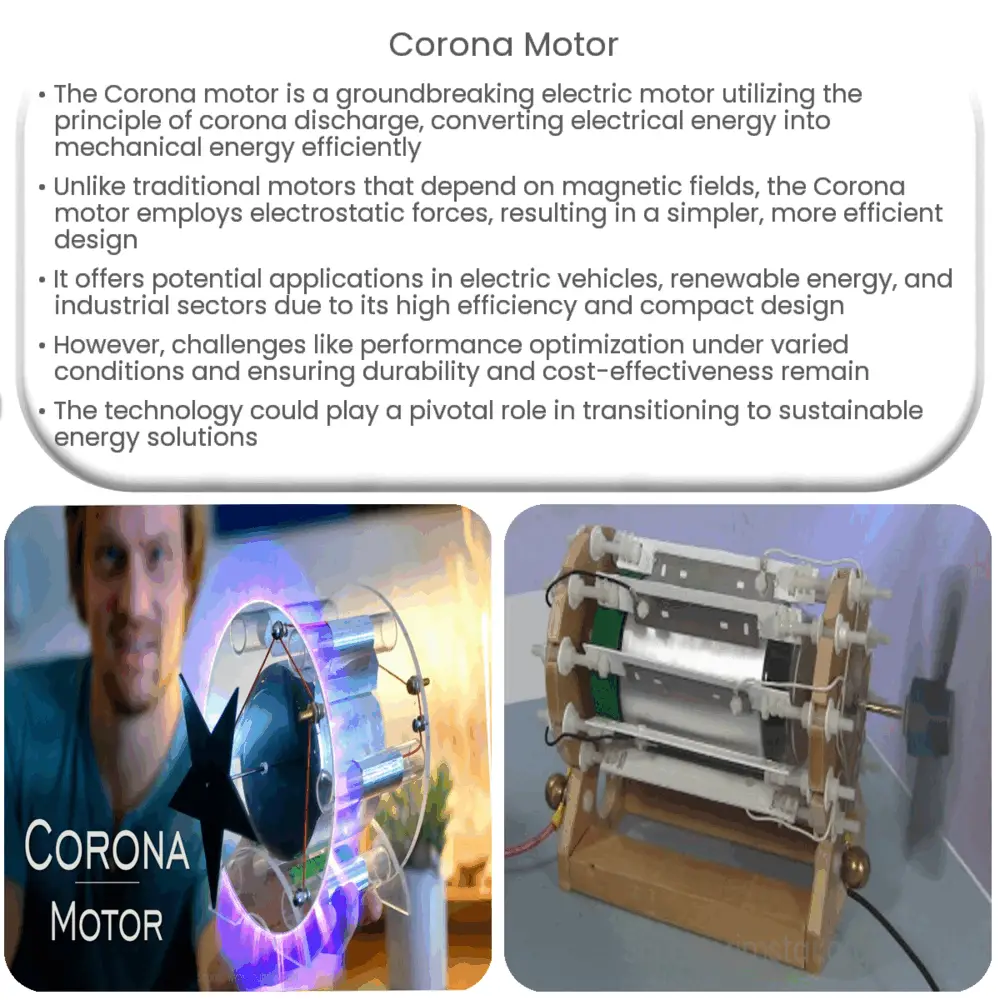The Corona motor is a highly efficient, lightweight electric motor that utilizes electrostatic forces from corona discharge for various applications.

Corona Motor: The Future of Electric Motors
Introduction
The Corona motor is a revolutionary electric motor that is expected to change the way we think about energy conversion and efficiency. It has been in development for a few years and promises to provide a more sustainable and efficient solution for various industries. In this article, we will delve into the principles behind the Corona motor, its potential applications, and the benefits it could bring to our world.
How Does the Corona Motor Work?
The Corona motor operates on the principle of corona discharge, a phenomenon where an electrically charged conductor releases ions into the surrounding air or gas. This process creates an electric field that causes the charged particles to move, generating an electric current. In the Corona motor, this current is used to drive a rotor, thus converting the electrical energy into mechanical energy.
Unlike traditional electric motors that use magnetic fields and require copper windings or permanent magnets, the Corona motor relies on the electrostatic forces generated by the corona discharge. This results in a simpler and more efficient design, as there are fewer components and less heat generated during operation.
Potential Applications of the Corona Motor
Due to its high efficiency and simple design, the Corona motor has a wide range of potential applications across various industries. Some of the most promising applications include:
- Electric Vehicles: The Corona motor could potentially replace conventional electric motors in electric vehicles (EVs), providing a more efficient and lightweight solution. This would improve the overall performance of EVs, including better range, reduced charging times, and increased acceleration.
- Renewable Energy: The Corona motor can be used in wind turbines and other renewable energy systems to convert the mechanical energy generated by the wind or water into electrical energy. Its high efficiency would lead to increased power output and reduced costs.
- Industrial Applications: In manufacturing, mining, and other industries, the Corona motor could replace traditional electric motors in various machines and equipment. The increased efficiency and reduced heat generation would lead to lower energy consumption, reduced maintenance requirements, and longer equipment lifespans.
Advantages of the Corona Motor
There are several advantages of the Corona motor over traditional electric motors, some of which are:
- Higher Efficiency: The Corona motor’s unique design allows it to operate at higher efficiencies than traditional motors. This results in lower energy consumption and reduced operational costs for industries and consumers alike.
- Lightweight and Compact: Due to its simpler design and lack of copper windings, the Corona motor is lighter and more compact than conventional electric motors. This can lead to reduced vehicle weight in EVs, improving their overall performance.
- Environmentally Friendly: The absence of copper windings and other rare-earth materials in the Corona motor makes it a more sustainable and eco-friendly option compared to traditional electric motors.
Challenges and Limitations
While the Corona motor holds immense promise, there are some challenges and limitations to be addressed before it can be widely adopted:
- Technical Challenges: The corona discharge process is affected by factors such as humidity, temperature, and pressure. Optimizing the motor’s performance in varying conditions requires further research and development.
- Reliability and Durability: Ensuring the long-term reliability and durability of the Corona motor is crucial for its success in various industries. This involves refining the design and materials used, as well as developing proper maintenance procedures.
- Cost and Scalability: For the Corona motor to be competitive with traditional electric motors, the manufacturing process must be cost-effective and scalable. This includes the development of new fabrication techniques and the establishment of a robust supply chain for necessary components.
Current State of Development and Future Outlook
Despite the challenges, researchers and engineers worldwide are actively working on the development and refinement of the Corona motor. Several prototypes have been successfully tested, demonstrating the motor’s potential in various applications. As further advancements are made, it is expected that the Corona motor will become a viable alternative to traditional electric motors in the near future.
The impact of the Corona motor on our world could be substantial. As industries and consumers increasingly embrace sustainable and energy-efficient technologies, the Corona motor has the potential to play a significant role in this transition. From electric vehicles to renewable energy systems, the adoption of the Corona motor could lead to a cleaner, greener, and more efficient future.
Conclusion
The Corona motor is an innovative and promising technology that has the potential to revolutionize the electric motor industry. Its unique design, higher efficiency, and environmentally friendly nature make it an attractive option for a variety of applications. As research continues and technical challenges are overcome, we can expect the Corona motor to become a significant player in the global push for sustainable and efficient energy solutions.

